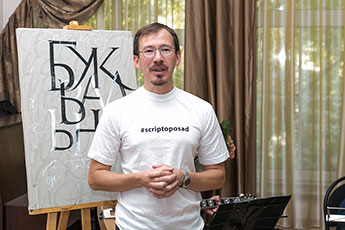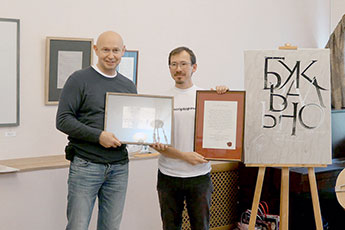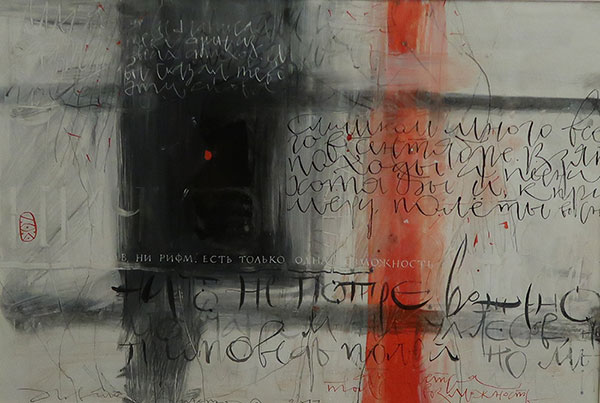Interview with Viktor Novikov
Calligrapher magazine was lucky to interview Viktor Novikov. Novikov is engaged in illustration, iconography and calligraphy, and teaches fine writing in the Town Center for Creative Leisure at the Russian Palace of Interests in Sergiev Posad. The artist shared the story of his creative formation, spoke about the connection of calligraphy with other arts, shared the history of the “Bukvalno” exhibition, and gave some tips to beginners.
- Viktor, please tell us about yourself. In the beginning of your creative path you were a member of the League of Watercolour Artists of Crimea. Did you work in the academic direction or seek to experiment?
- Indeed, I had such an experience. You have to understand that the League united not academicians but free artists based on common interests. We arranged a few exhibitions, and then decided to formalize our activities.
I’ve been fond of drawing since childhood. I graduated from the Design Lyceum at the Center for Technical Creativity in Sevastopol, entered Kharkov State Academy of Design and Arts. I received a classical education, but since I studied in the graphics department, there was always some convention. There were many paths for development in the learning process, and every tool that fell into my hands shaped my style.
I then studied at the Icon Painting School of the Moscow Theological Academy. And in 2015 I was admitted to the Union of Artists of Russia.
- But what caused you to switch from graphics to icon painting?
- It was a destiny. I, too, sometimes wonder: why did it happen? My wife-to-be told me about the school, and I thought that, indeed, icon painting was an interesting tradition; and there were also some personal impressions. And thus I ended up there.
- And how did you switch from icons to calligraphy?
- I never switched from them, I only added one more form of art. I still do graphics, icon painting, and watercolour. It all depends on the mood. Calligraphy is always with me, since I teach it. Now I am preparing a solo exhibition with different kinds of works.
- Where does your interest in the art of fine writing come from?
- The key factor was a certain charm of the letter I felt when studying in the institute. One day I learned that Archpriest Pavel Velikanov offered to introduce the courses of fine writing. When I heard the word calligraphy, something woke up in me, I felt the kinship of the soul. Now I choose my practices according to my mood: watercolour, tempera, or calligraphy. It is more difficult, because I know I must be responsible and develop every skill, but I do my best.
- What is calligraphy for you?
- It is one of the manifestations of how composition can present itself. I will repeat myself saying that, as an artist, I have an internal desire to do something. In the beginning there is no picture of a result, only the intention. I do not know what will come of it. Then an image, a miniature, a work corresponding to some event, is gradually formed. And sometimes it has the form of calligraphy.
I study it in terms of how to work with the construction of a picture. I’ve been bearing hard on my students: I don’t want them to just write nicely, but to be interested in the process from different points of view: what tools to use, what colours to apply, how to arrange it, etc. I personally enjoy it a lot.
- And what do you get from the classes?
- An extraordinary pleasure and enlightenment. Besides, one of the directions of my work is teaching. After classes, I feel like I can fly.
- Who can you call your calligraphy teacher? Whose works did you try to imitate in the beginning?
- Yves Leterme. He came to Moscow with a crash course workshop, but I learned about it only afterwards. His approach to work is quite special, his calligraphy is not just letters on a white sheet. Yves Leterme is a student of the famous Brody Neuenschwander, the author of the Black in White Silence performance.
- Relying on your own experience of studying and teaching – what do you think is the best way to start learning calligraphy?
- Drawing from the experience I’ve gathered teaching, I came to the conclusion that you just need to give a person a round brush and watch them try to write something. If a student realizes that there is beauty in a letter, then everything will work out. Although historically the broad-end instrument came first, the brush is more familiar to the hand. The beginner looks at the pointed pen and does not know what to do, but the brush is familiar to them. The joy from creative work gives impetus to the students’ further development, but if they see no success, many would not want to go any further. Systematic classes and repetitions are important, but many may simply give up waiting for success, so positive reinforcement is also crucial.
- In your works you often use ink, broad pen and brush. Why such a choice?
- I love to combine these basic tools, as each has unique expressive means. I like to experiment. For example, now I often use a spatula. Artists actually like to use strange tools, they would often drop to a drugstore or a hardware store for materials to use in their creative practices.
- How would you describe your style?
- This one is the trickiest question. Recently, one person helped me, saying that it was closest to expressionism. I am not a realist, I do not paint from life, but I express and record inner experiences, and the more tools serve this, the better.
- What was the inspiration behind the ASKME series? It presents a very interesting contrast of the emotionally written letter and the canonically executed text.
- The idea is to try and adopt the expressive Japanese approach to writing. Although I used a flat broad brush instead of a round one, I tried to imitate Japanese movements and combine them with the modern European writing. Thus I tried to reconcile East and West in my work.
– In some of your works there is an unusual joint and separate spelling of words, unexpected hyphenations. What is the reason?
- Those are not the most important things in calligraphy. I am an artist, a free one. Besides, if you look at old handwritten books, you will see that there was no hyphenation in them, for the sake of saving space. The lines were brought to the very end.
- And where do you source your texts? Do you write them yourself?
-Yes, often they are my lyrics. It is easier this way: they are always at hand, and sometimes even born in the process of creation.
- Do you have a favourite letter?
- In the Latin alphabet I find ‘g’ very beautiful, and of the Russian, I’d love to find a way with ‘ж’.
- Do you have a favourite work of your own authorship?
- I do. When we were hanging out the works, my son Kolya approached a piece and said it was the best. It is titled “Opportunity” and consists of fragments of poems. It is appealing and warm, but with an element of avant-garde.
- What project are you currently working on?
- Preparing for a personal exhibition. There will be paintings as well as large-scale calligraphy works.
Next year I want to arrange another exhibition like “Bukvalno”. It is very important to hold such exhibitions, they provide a great creative boost. I was surprised to discover that my students had been preparing new works specifically for the exhibition, despite them having fine works already. Everyone felt inspired to create something new and serious. So these things give motivation and boost a great growth.
- How do you determine what works to exhibit?
- It's not easy. Usually I have a stack of works lying on my desk, I take a piece from it and listen to my inner feelings, picking out those that resonate with me for exhibiting. I could have presented more of my works at the “Bukvalno” exhibition, but what would be the point? It would have been a solo exhibition, and our goal was different.
- What difficulties do you face in the process of preparing an exhibition?
- Technical ones: advertising, making labels, etc. I need to think of everything, prepare a table, and so on. It is much easier with the works: no problem with painting and arranging them.
- Do you think calligraphy should be distinguished as a separate form of art? And why?
- Yes and no. It depends on the author’s goals. At first, a person is learning. Then he or she makes some progress and reaches a certain level, which can impress the others. However, if he or she does not progress further, does not improve their composition, their artistic development will stop.
Painting and calligraphy are not the same thing. One of my students was a painter, but he was failing in calligraphy. You need a light hand, otherwise you’ll fail. I distinguish graphics from painting. They require different sets of mind. You need to feel the end of the line to be a calligrapher. In oil painting, a stroke of the brush is something indefinite, while in graphics and calligraphy you need to know how to finish the line. The Japanese are very good at that: they make everything finite, they put meanings into the characters. What matters is inner aesthetics, perfectionism. You will not produce magic without them.
- So is it impossible to become a calligrapher without artistic education?
- Yes, it is quite possible! As well as to become a painter without artistic education. If a person takes a brush in their hands and delves into the world of painting, like Van Gogh, he or she can become an artist. Anyone can achieve great things, one just needs to study the works of masters and work hard. What is crucial is learning to analyse. You can do without academic education, but you need a certain boost.
- Where can one learn calligraphy?
- You can find the basics on the Internet. Then go to the Contemporary Museum of Calligraphy, look at the works, and memorize the names. That might be enough, in case you can be satisfied with creating an ideal, in terms of correctly written and composed, work. That would be level two. Level three is where you think, speculate about your end point, look for combinations of tools and components. Calligraphy is practically painting: you can create colour combinations, discover compositional twists. This is where the art begins. If this is your approach, then calligraphy can be a certain form of art for you. Whereas, if you don’t strive to progress, it will be just a craft for you.
- What qualities should a calligrapher possess?
- He or she must be a good person. Sadly, we must admit that human genius goes in combination with many things. There are talented crafters, who are unhappy and succumb to passions, drink excessively, etc. But would there be the genius in them without all that? As for me, either there’s no genius in me, or there’s something evil in me I haven’t yet discovered myself. But it suffices to just be a good person to be a calligrapher.
- What does the future hold for the art of fine writing?
- I hope that calligraphy will take its place, will appear in schools and universities. Art colleges offer something like that within the typography course, but only for a short period of time. And I hope that it will result in a separate field that helps develop a balanced person.
- What can calligraphy teach children?
- It gives an aesthetic education, through which the children understand that the letter is something that shouldn’t be neglected, that they should protect the writing, the whole culture, and therefore other people also deserve to be treated with respect. If a mathematician studies both exact sciences, sports, music, and calligraphy, they will only profit from that. A complex approach is important. I don't mean to say that only the art of fine writing should be developed: everything should. So that we’ll see playgrounds where one child plays with a ball, another reads a book, a third one climbs a rope, and a fourth one practices calligraphy – like they do in Japan.
- What current trends do you see in calligraphy?
- You get to see a combination of calligraphy with drawing more often. When a calligrapher writes a hieroglyph, he believes that he can change it. We should also learn the laws of constructing a letter to be able to change them and create something new. I try to move in that direction. For the Chinese and the Japanese, calligraphy equals fine art, while for us, for the European mentality, the letters are solid and unchanging. You have to look for a new solution. There’s a drill when you write one and the same letter many times. At first you write the classic variants, and then you begin to improvise. And it's great! I hope that calligraphy will move towards this artistic freedom, and we will all become Japanese, in a good way.
So you have to move forward and look for something new!
When there are no words left, the meaning is still preserved.






